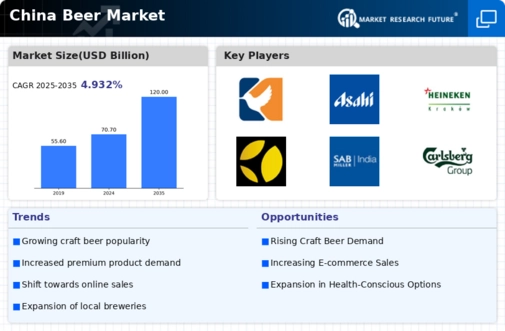The beer market in China is characterized by a dynamic competitive landscape, driven by evolving consumer preferences and increasing demand for diverse product offerings. Major players such as Anheuser-Busch InBev (BE), China Resources Snow Breweries (CN), and Heineken N.V. (NL) are actively shaping the market through strategic initiatives. Anheuser-Busch InBev (BE) focuses on innovation and premiumization, introducing craft-style beers to cater to the growing segment of discerning consumers. Meanwhile, China Resources Snow Breweries (CN) leverages its extensive distribution network to maintain a dominant market share, emphasizing local tastes and preferences. Heineken N.V. (NL) is pursuing regional expansion, particularly in tier-2 and tier-3 cities, where it aims to capture emerging consumer bases. Collectively, these strategies contribute to a competitive environment that is increasingly focused on product differentiation and localized marketing efforts.
Key business tactics within the beer market include localizing manufacturing and optimizing supply chains to enhance efficiency and responsiveness to market demands. The competitive structure appears moderately fragmented, with several key players vying for market share while also facing competition from local breweries. This fragmentation allows for a diverse range of products, catering to various consumer segments, while the influence of major players remains significant in shaping market trends and consumer preferences.
In October 2025, Heineken N.V. (NL) announced a partnership with a local craft brewery to co-develop a new line of beers tailored to regional tastes. This strategic move underscores Heineken's commitment to innovation and local engagement, potentially enhancing its brand appeal among younger consumers who favor unique and locally-inspired flavors. Such collaborations may also facilitate knowledge transfer and operational synergies, further strengthening Heineken's market position.
In September 2025, Anheuser-Busch InBev (BE) launched a digital marketing campaign aimed at promoting its premium beer portfolio, utilizing advanced analytics to target specific consumer demographics. This initiative reflects a broader trend towards digitalization in the industry, as companies increasingly leverage data-driven insights to refine their marketing strategies and enhance consumer engagement. The emphasis on digital channels may also improve brand loyalty and customer retention in a competitive market.
In August 2025, China Resources Snow Breweries (CN) expanded its production capacity by investing in a new brewery facility in central China. This expansion is strategically significant as it positions the company to better serve the growing demand in inland regions, where beer consumption is on the rise. By enhancing its production capabilities, China Resources Snow Breweries (CN) aims to solidify its market leadership and respond more effectively to regional consumer preferences.
As of November 2025, current trends in the beer market are increasingly defined by digitalization, sustainability, and the integration of artificial intelligence in operations. Strategic alliances are becoming more prevalent, allowing companies to pool resources and expertise to navigate the complexities of the market. Looking ahead, competitive differentiation is likely to evolve, shifting from traditional price-based competition to a focus on innovation, technology, and supply chain reliability. This transition may enable companies to better meet consumer expectations and adapt to changing market dynamics.


















Leave a Comment